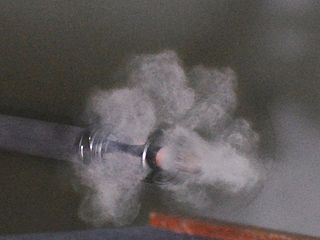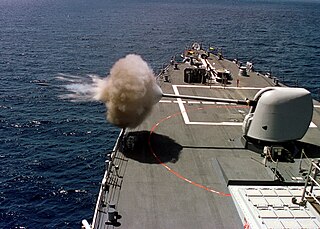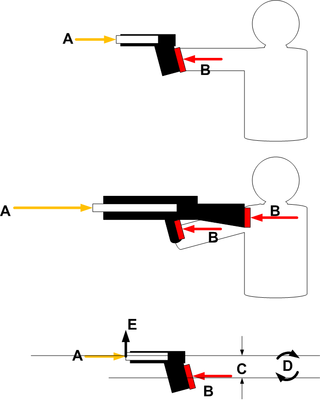
A firearm is any type of gun designed to be readily carried and used by an individual. The term is legally defined further in different countries.

A bullet is a kinetic projectile, a component of firearm ammunition that is shot from a gun barrel. They are made of a variety of materials, such as copper, lead, steel, polymer, rubber and even wax; and are made in various shapes and constructions, including specialized functions such as hunting, target shooting, training, and combat. Bullets are often tapered, making them more aerodynamic. Bullet size is expressed by weight and diameter in both imperial and metric measurement systems. Bullets do not normally contain explosives but strike or damage the intended target by transferring kinetic energy upon impact and penetration.

A cartridge or a round is a type of pre-assembled firearm ammunition packaging a projectile, a propellant substance and an ignition device (primer) within a metallic, paper, or plastic case that is precisely made to fit within the barrel chamber of a breechloading gun, for the practical purpose of convenient transportation and handling during shooting. Although in popular usage the term "bullet" is often informally used to refer to a complete cartridge, it is correctly used only to refer to the projectile.

A muzzle brake or recoil compensator is a device connected to, or a feature integral to the construction of, the muzzle or barrel of a firearm or cannon that is intended to redirect a portion of propellant gases to counter recoil and unwanted muzzle rise. Barrels with an integral muzzle brake are often said to be ported.

A flash suppressor, also known as a flash guard, flash eliminator, flash hider, or flash cone, is a muzzle device attached to the muzzle of a rifle that reduces its visible signature while firing by cooling or dispersing the burning gases that exit the muzzle, a phenomenon typical of carbine-length weapons. Its primary intent is to reduce the chances that the shooter will be blinded in low-light shooting conditions. Contrary to popular belief, it is only a minor secondary benefit if a flash suppressor reduces the intensity of the flash visible to the enemy.

Rimfire ammunition is a type of firearm metallic cartridge whose primer is located within a hollow circumferential rim protruding from the base of its casing. When fired, the gun's firing pin will strike and crush the rim against the edge of the barrel breech, sparking the primer compound within the rim, and in turn ignite the propellant within the case. Invented in 1845, by Louis-Nicolas Flobert, the first rimfire metallic cartridge was the .22 BB Cap cartridge, which consisted of a percussion cap with a bullet attached to the top. While many other different cartridge priming methods have been tried since the 19th century, only rimfire and the later centerfire cartridges survive to the present day with regular usages. The .22 Long Rifle rimfire cartridge, introduced in 1887, is by far the most common ammunition in the world today in terms of units sold.

A gun barrel is a crucial part of gun-type weapons such as small firearms, artillery pieces, and air guns. It is the straight shooting tube, usually made of rigid high-strength metal, through which a contained rapid expansion of high-pressure gas(es) is used to propel a projectile out of the front end (muzzle) at a high velocity. The hollow interior of the barrel is called the bore, and the diameter of the bore is called its caliber, usually measured in inches or millimetres.

A gunshot is a single discharge of a gun, typically a man-portable firearm, producing a visible flash, a powerful and loud shockwave and often chemical gunshot residue. The term can also refer to a ballistic wound caused by such a discharge.

The .22 Long Rifle or simply .22 LR or 22 is a long-established variety of .22 caliber rimfire ammunition originating from the United States. It is used in a wide range of rifles, pistols, revolvers, smoothbore shotguns, and submachine guns.
Internal ballistics, a subfield of ballistics, is the study of the propulsion of a projectile.

A blank is a firearm cartridge that, when fired, does not shoot a projectile like a bullet or pellet, but generates a muzzle flash and an explosive sound like a normal gunshot would. Firearms may need to be modified to allow a blank to cycle the action, and the shooter experiences less recoil with a blank than with a live round. Blanks are often used in prop guns for shooting simulations that have no need for ballistic results, but still demand light and sound effects, such as in historical reenactments, special effects for theatre, movie and television productions, combat training, for signaling, and cowboy mounted shooting. Specialised blank cartridges are also used for their propellant force in fields as varied as construction, shooting sports, and fishing and general recreation.

Transitional ballistics, also known as intermediate ballistics, is the study of a projectile's behavior from the time it leaves the muzzle until the pressure behind the projectile is equalized, so it lies between internal ballistics and external ballistics.

Gunshot residue (GSR), also known as cartridge discharge residue (CDR), gunfire residue (GFR), or firearm discharge residue (FDR), consists of all of the particles that are expelled from the muzzle of a gun following the discharge of a bullet. It is principally composed of burnt and unburnt particles from the explosive primer, the propellant (gunpowder), and vaporized lead. The act of firing a bullet incites a very violent explosive reaction that is contained within the barrel of the gun, which can cause the bullet, the barrel, or the cartridge to become chipped. Meaning gunshot residue may also included metal fragments from the cartridge casing, the bullets jacket, as well as any other dirt or residue contained within the barrel that could have become dislodged.

Snake shot refers to handgun and rifle cartridges loaded with lead shot canisters instead of bullets, much like large caliber canister shot. Snake shot is generally used for shooting snakes, rodents, birds, and other pests at very close range. The most common snake shot cartridge is .22 Long Rifle loaded with No. 12 shot. From a standard rifle these can produce effective patterns only to a distance of about 3 metres (10 ft), but in a smoothbore shotgun that can extend as far as 15 metres (50 ft).
A muzzle booster or recoil booster is a device fixed to the muzzle of a firearm, intended to harness the energy of the escaping propellant to augment the force of recoil on portions of the firearm. In spite of its name, a muzzle booster does not increase muzzle force or velocity but instead is usually used to improve the reliability and/or rate of fire of a recoil operated firearm. The muzzle booster is distinct from the muzzle brake, which is designed to use the propellant gases to reduce the recoil of the firearm. However, unlike a muzzle brake, a muzzle booster uses the pressure of the expanding gases, rather than the reaction force, and it does not alter the felt recoil of the weapon, it merely adds more energy to the operating components.

A blank-firing adapter or blank-firing attachment (BFA), sometimes called a blank adapter or blank attachment, is a device used in conjunction with blank ammunition for safety reasons, functional reasons or a combination of them both. Blank firing adapters are required for allowing blank ammunition to cycle the bolts of most semi-automatic and automatic firearms. It can also be a safety feature designed to break up the plugs replacing the bullet in military blanks as well as divert the hot gases from a blank discharge out to the sides, reducing the risk of injury to the target of an aimed shot.
The following are terms related to firearms and ammunition topics.

Muzzle rise, muzzle flip or muzzle climb refers to the tendency of a firearm's or airgun's muzzle to rise up after firing. It more specifically refers to the seemingly unpredictable "jump" of the firearm's muzzle, caused by combined recoil from multiple shots being fired in quick succession. It has an adverse effect on maintaining accuracy with using automatic weapons or rapid-firing semi-automatic firearms, as a moving muzzle can throw off the shooter's aim, causing subsequent shots to miss the intended target.

A silencer, also known as a sound suppressor, suppressor, or sound moderator, is a muzzle device that reduces the acoustic intensity of the muzzle report and muzzle rise when a gun is discharged, by modulating the speed and pressure of the propellant gas from the muzzle and hence suppressing the muzzle blast. Like other muzzle devices, a silencer can be a detachable accessory mounted to the muzzle, or an integral part of the barrel.
An abrasion collar, also known as an abrasion ring or abrasion rim, is a narrow ring of stretched, abraded skin immediately surrounding projectile wounds, such as gunshot wounds. It is most commonly associated with entrance wounds and is a mechanical defect due to a projectile's penetration through the skin. It is caused by a temporary over-stretching of the skin surrounding the projectile's point of penetration. Like all skin abrasions, the abrasion collar tends to dry out due to scraping away of the skin's outer layers and the collapse and dehydration of the underlying cells; it therefore becomes easier to discern with time. This defect is most often seen around rifled firearm entrance wounds due to the striations or grooves in the bullet's surface caused by the rifling on the inside of the weapon's barrel; however, certain other high-velocity projectile wounds can also have the same effect.
















